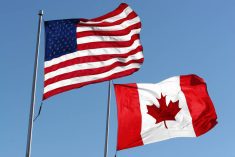The Belt & Road Initiative is intended to enhance trade with Europe, Africa and Asia, but loss of control is recent worry
China’s $2 trillion version of globalization is encountering some resistance.
In 2013, the country embarked on its costly Belt & Road Initiative (BRI), which is essentially a project designed to revitalize the ancient Silk Road and enhance trade with Europe, Asia and Africa.
Chinese state-owned enterprises have already invested in more than 1,676 BRI projects in 185 countries.
Those investments include massive projects such as the 12,000-kilometre-long China-Europe rail link that is twice as fast as transporting goods by sea, according to a document prepared by the Belt and Road Advisory.
Read Also

Farming Smarter receives financial boost from Alberta government for potato research
Farming Smarter near Lethbridge got a boost to its research equipment, thanks to the Alberta government’s increase in funding for research associations.
Improved transportation links is a big part of the BRI, but a lot of politics is also tied up in the megaproject, says a former Canadian ambassador to China.
David Mulroney said one of China’s objectives is to pacify dissident countries in central Asia by making substantial infrastructure investments in nations where it has security concerns.
Those investments promote China’s influence in the region, secure territories of strategic concern and give the country’s massive excess of construction and infrastructure capacity someplace to go.
China used more concrete between 2011 and 2013 than the United States did in the entire 20th century, according to the Belt & Road Advisory. China’s primary infrastructure needs have been met, and the country is now looking to use its excess construction capacity abroad.
However, some countries in Asia, Europe and Africa are starting to become wary about China’s BRI motives.
“There is just a growing concern in a lot of countries about their indebtedness to China as they end up building roads to nowhere, ports they don’t need and buildings they will never have use for,” said Mulroney, who was ambassador from 2009-12.
China’s BRI projects amount to 20 to 50 percent of gross domestic product in countries like Pakistan, Indonesia, Laos and Kazakhstan, according to the Belt and Road Advisory.
“There is a lot of pushback to One Belt, One Road from countries that now have a sense of what China is all about,” said Mulroney.
For instance, last year Malaysia cancelled $22.3 billion in BRI rail and gas pipeline projects to avoid going into further debt, according to a Business Insider article.
Malaysian President Mahathir Mohamad said the country didn’t need the projects and that the debt could bankrupt the country.
China has been criticized for its activities in Sri Lanka. Bloomberg reports that the country was forced to sell one of its ports to a Chinese firm for $1.1 billion to help pay off mounting debt from a variety of infrastructure projects.
“What China tries to do is divide and conquer. Pick out the weak and those that are the most wobbly,” said Mulroney.
He noted that France has not signed onto the BRI initiative, but Italy has because the Italian government is “dysfunctional.”
As China continually improves the transportation infrastructure with Europe, Asia and Africa, there is a concern it will become less reliant on agricultural exports from North and South America.
COFCO International, a Chinese-owned agricultural trading firm, recently announced it plans to double its grain purchases from the Black Sea region over the next two to three years.
Arlan Suderman, chief commodities economist with INTL FCStone, said the announcement may be related to the BRI initiative but he suspects it has more to do with the trade war between China and the United States.
China is telegraphing that it has other ways of sourcing the grains and oilseeds that it desperately needs.
“It is another part of their effort to diversify their suppliers,” he said.
When the trade war first erupted and China slapped a 25 percent import duty on U.S. soybeans, it said it would start sourcing more soybeans from Brazil, India, Paraguay and other countries.
China doesn’t want to be “held hostage” by one exporter, said Suderman. Instead, it wants to be able to play suppliers off against one another.
Mulroney isn’t worried about Canada losing market share in the Chinese market in the long run, despite the current ban on canola exports.
That is because what China needs more than anything in the long run is reliable suppliers of high quality agricultural products, and Canada can deliver on both of those fronts.
“In a world where reliable suppliers are not abundant, we stand out,” he said.
“China is so successful in its bluff and bluster that it can get you to ignore that.”


















